Citing Manet in her notebooks,1 Berthe Morisot wrote: “Edouard: It is possible make plein-air bedroom scenes, blue in the morning, lilac in the daytime and orange in the evening.”2 The Manet/Morisot relationship has long figured in critical interpretations of Morisot’s work from the earliest reviews by Mallarmé and Rivière.3 In a parallel vein, twentieth- and twenty-first-century criticism on Morisot has veered towards the biographical, largely due to interiors being understood as her preferred subject matter, in opposition to the plein-air paintings of her Impressionist counterparts.4 The formal aspects of Morisot’s work and more specifically her modernity in terms of facture, gaze, and composition, rather than subject choice, have received far less attention.5 This article focuses thus on what I term the plein-air interior in Morisot’s work in order to draw attention to her formal contribution to Impressionism and, more broadly, to modern art. My argument builds upon recent writings on Impressionist aesthetics such as those by Michael Fried that question the role of figure painting in Impressionism,6 but it is also informed by a concentrated engagement with a series of neglected critical writings by nineteenth and early-twentieth-century critics who first identified how the originality of Morisot’s work lay in its formal aspects.7 I show how these early critics, often despite their overtly conservative and misogynistic attitudes, recognized Morisot’s contribution to modernist aesthetics. The essay draws upon this criticism to discuss plein-air painting in context before analysing key interior paintings by Morisot. I argue that in works like The Cradle (1872), Young Woman Seated on a Sofa (1879), Young Woman at a Window (Summer) (1878), and The Psyche Mirror (1876), Morisot pushes the boundaries of plein-air aesthetics to create an art that brings together figure and landscape.
Mallarmé, Duranty and the idea of plein-air painting
While Morisot has become known for her treatment of subjects in the interior, it is important to note that landscape, and in a broader sense nature, was at the heart of her aesthetics and pivotal to her success as an Impressionist. On the one hand, her submissions to the Impressionist exhibitions (1874, 1876, 1877, 1880, 1881, 1882, 1886)8 always included landscape paintings; on the other, in her writings, the truthful depiction of nature is an ongoing subject of reflection. Therefore, an interrogation of what Morisot understood by “nature” and her influences (both strategic and artistic) is necessary to understand how her plein-air interior paintings are conceived.
Returning to nineteenth-century criticism allows us to see Morisot’s plein-air works in context. Edmond Duranty’s writings on Impressionism have regularly been cited for their emphasis on the interior,9 yet the critic’s comments on the home are part of a much larger discussion on nature, informed by his reading of Zola and Naturalism. Originally published in 1876 as a thirty-eight-page pamphlet, the text offers a detailed account of the movement, without naming it or any of the artists concerned.10 A key section in the pamphlet focuses on the relationship between color and light, which Duranty presents as a scientific discovery in painting:
What then do these painters contribute?
A new method of color. Of drawing, and a gamut of original points of view. … In the field of color they made a genuine discovery for which no precedent can be found. … They are not merely preoccupied by the refined and subtle play of colors that emerges when they observe the way the most delicate ranges of tone either contrast or intermingle with each other. Rather, the real discovery of these painters lies in their realization that strong light mitigates color, and that sunlight reflected by objects tends, by its very brightness, to restore that luminous unity that merges all seven prismatic rays into one single colorless beam—light itself.
Proceeding by intuition, they little by little succeeded in splitting sunlight into its rays, and then reestablishing its unity in the general harmony of the iridescent color that they scatter over their canvases. With regard to visual subtleties and delicate blending of colors, the result is utterly extraordinary. Even the most learned physicist could find nothing to criticize in these painters’ analysis of light.11
Of course, this scientific experiment could only be achieved by painting en plein-air and leaving the studio behind, as Duranty relates:
The very first idea was to eliminate the partition separating the artist’s studio from everyday life. … It was necessary to make the painter come out of his sky-lighted cell, his cloister, where his sole communication was with the sky—and to bring him back among men, out in the real world. … Our lives take place in rooms and streets, and rooms and streets have their own special laws of light and of visual language.12
Therefore, for Duranty, the emphasis on light and the role of both outdoors and indoors in the creation of a truthful depiction of reality is what defined the Impressionists. While plein-air painting had been popular with Corot, Millet, and Courbet, until Manet’s radical aesthetics emerged, works that sought to capture nature were still finished in the studio. Being faithful to the perception of reality was, as Duranty explains, the aim of the new school, and the idea of truthfulness was at its core. Truth was also central to Mallarmé’s understanding of Impressionism, which as we will see is of particular importance in relation to Morisot, with whom he maintained a close personal and artistic relationship.13 “The Impressionists and Edouard Manet” appeared in English on September 30, 1876, in The Art Monthly Review and Photographic Portfolio, published in London. The poet’s text is more direct than his typically allusive writings, characterized by their suggestivity and ambiguity,14 and instead offers an account of plein-air painting that may be seen to reflect its truthful and simple stance in relation to nature:
Open air:—that is the beginning and end of the question we are now studying. …
This search after truth, peculiar to modern artists, which enables them to see nature and reproduce her, such as she appears to just and poor eyes, must lead them to adopt air almost exclusively as their medium, or at all events to habituate themselves to work in it freely and without restraint: there should at least be in the revival of such a medium, if nothing more, an incentive to a new manner of painting. … As no artist has on his palette a transparent and neutral color answering to open air, the desired effect can only be obtained by lightness or heaviness of touch, or by the regulation of tone. Now Manet and his school use simple color, fresh, or lightly laid on, and their results appear to have been attained at the first stroke, that the ever-present light blends with and vivifies all things. As to the details of the picture, nothing should be absolutely fixed in order that we may feel that the bright gleam which lights the picture, or the diaphanous shadow which veils it, are only seen in passing, and just when the spectator beholds the represented subject, which being composed of a harmony of reflected and ever-changing lights, cannot be supposed always to look the same, but palpitates with movement, light, and life. 15
What is clear in this extract is that “this search after truth” and “the ever-present light” are interrelated and that the handling or facture is central to creating the plein-air effect. Mallarmé’s text is particularly relevant to Morisot’s painting, especially in relation to the artistic handling. Morisot’s work in landscape underlies her œuvre. This is important because, as we will see, once Morisot moves into her ambitious interior scenes, the plein-air effects are still paramount. This signals, as I will argue, a neglected aspect of her contribution to modern art, where ambitious figure painting and the techniques of landscape are fused.
In a letter to Edma, discussing the 1869 Salon, where on the one hand, she mentions that “landscapes bore her,”16 Morisot writes of the play between figure and landscape in Bazille’s View of the Village (1869):
The tall Bazille has painted something that I find very good. It is a little girl in a light dress seated in the shade of a tree, with a glimpse of a village in the background. There is much light and sun in it. He has tried to do what we have so often attempted—a figure in the outdoor light—and this time he seems to have been successful.17
The artist’s comments here are insightful, revealing the extent to which she considered the role of figure and landscape and the potentialities of light in transforming the interior. It is interesting that in the same letter, she picks out Fantin-Latour18 for criticism just after she admires the plein-air of Bazille.19 Where in 1865 Fantin proclaimed the potential of plein-air painting—“How one could make something beautiful with figures in open air on the grass!”20—by the end of that decade the artist had become a vocal detractor of Manet and his followers. In the same letter Morisot is also critical of Corot because of his undermining of plein-air painting: “I think he spoiled the étude we admired so much when we saw it at his home, by redoing it in the studio.”21 It is not surprising that this ongoing tension between landscape and interior and between studio/plein-air painting was to have a profound impact on Morisot and the evolution of her art, given the centrality of figures like Fantin and Corot to her early career.
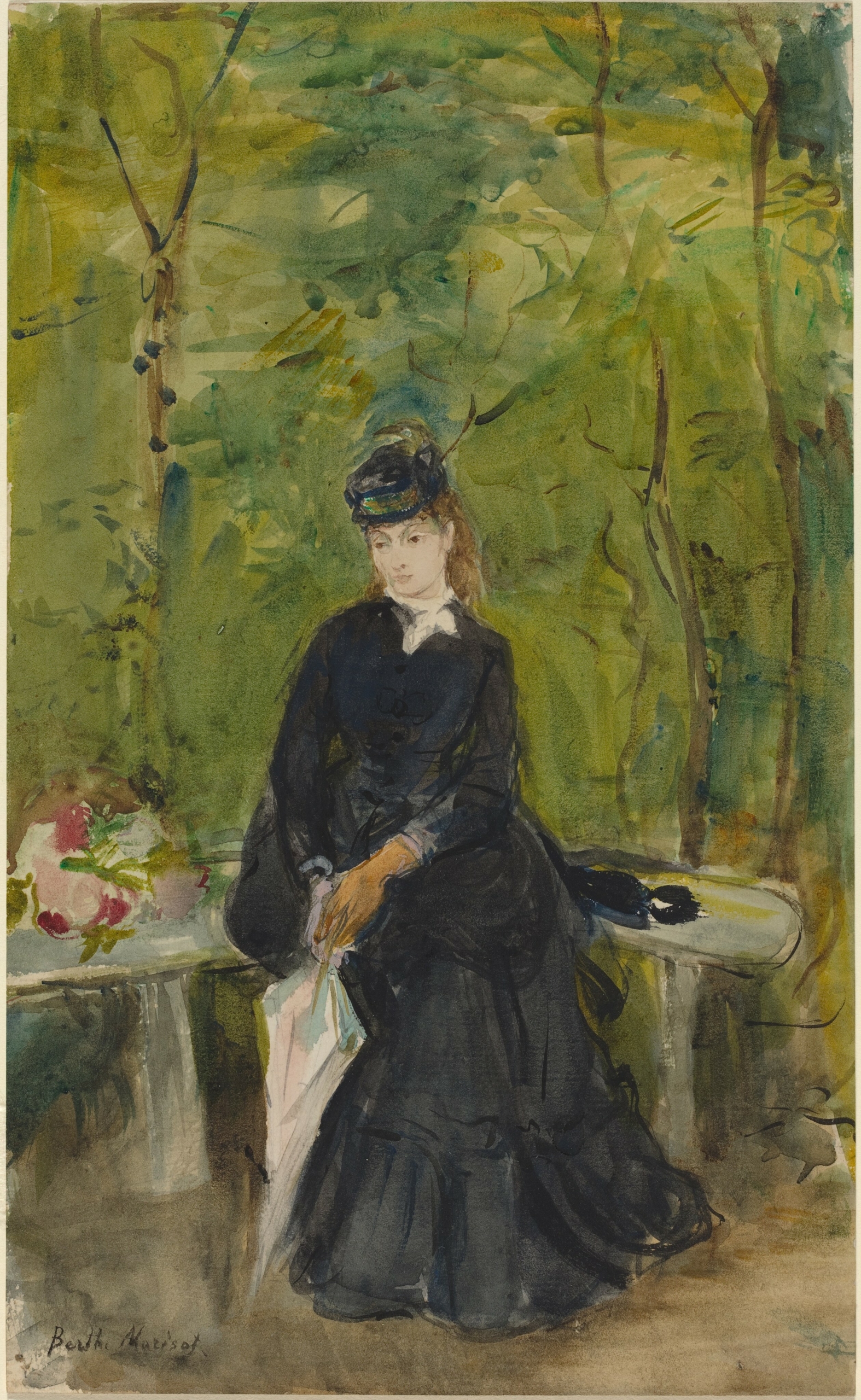
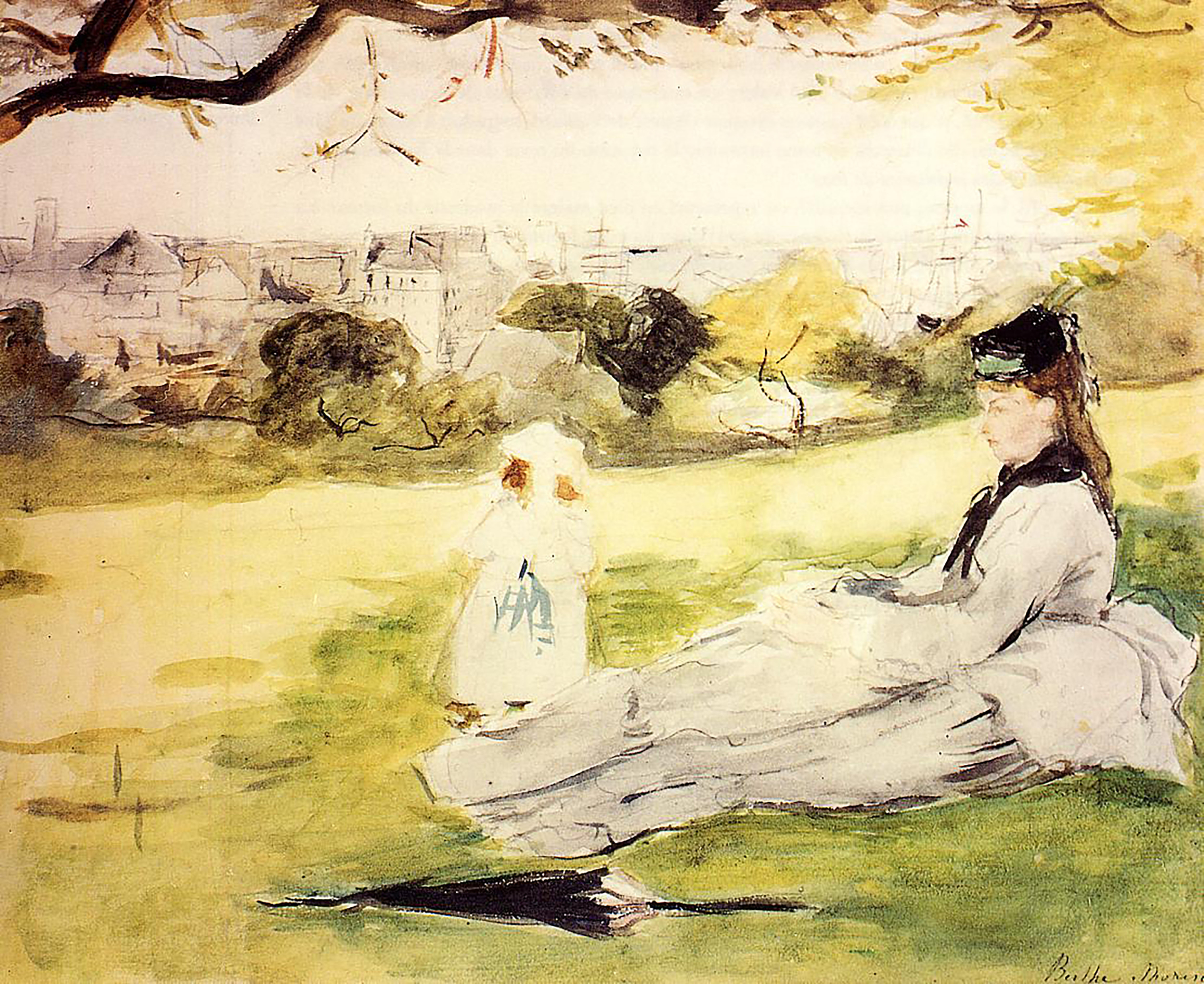
The later scenes of plein-air interiors have their genesis in pictures from the late 1860s and early 1870s. Some of these are watercolors, which are important from an aesthetic perspective. Morisot had early success with watercolors, and as a medium, it was seen as more suitable for women.22 In the watercolors, Young Woman on a Bench (1871) and Woman and Child Sitting in a Meadow (1871), key elements that would shape Morisot’s later interior plein-air works are visible: namely the fashionable female figure in greenery and explorations in light (figs. 1 and 2). In the first, Edma, elegantly dressed in black and white, is seated outdoors and enclosed in greenery. Here, there is no shade, and the light falls directly upon Edma’s face, white scarf, and parasol. This experimentation with the effect of direct light is seen more clearly in what has been recognized by both nineteenth-century and contemporary critics as one of Morisot’s masterpieces, Woman and Child Sitting in a Meadow, which Degas acquired.23 The simplicity of the sketch, together with the use of a light palette where white dominates, in both this and watercolors like On the Cliff (1873) allows a sense of transience, creating what Jean-Dominique Rey describes as “an increasingly allusive, atmospheric art.”24 As Fourreau points out, Morisot made special use of the effect of water on white paper:
no one better than she knew how to make use of the whiteness of paper, sometimes allowing it to appear in all its brilliance so as to give the greatest possible force and freshness to the touches of color next to it; sometimes allowing it to shine through by diluting the color till it became almost a question of painting with water, and by these means obtained the subtlest gradations, the finest and most delicate neutralisations by the side of vibrating accents of light and color.25
Morisot’s work in watercolor no doubt influenced her experimentation in oil and pastel from the perspective of both form and subject.26 What is clear is that the trope of the female figure outdoors and the evocation of natural light were two core aesthetic elements of Morisot’s painting. Drawing upon the writings of the first critics to view these works at the Impressionist Exhibitions, I interrogate how Morisot manipulated outdoor and indoor scenes through her use of light and color, and I question the effect upon spectators. We will see how gender and dress, as well as home furnishing and décor, play a substantial role in the creation and the critical reception of Morisot’s plein-air interior scenes. Most interestingly, however, we see how the language of this criticism, despite appearances, signals Morisot’s modernity through its covert emphasis on her radical aesthetics.
Gender, nature and fabric in the critical reception of Morisot’s early plein-air and interior scenes
As has been well-documented, the Impressionist exhibitions from 1874–88 were reviewed in all the Parisian, as well as some regional, presses.27 Critics were almost always struck by Morisot’s technique. As Myers relates, “Far bolder than that of her of her Impressionist cohort, Morisot’s sketch aesthetic was the focus of most critical commentary on her paintings, whether positive or negative, throughout most of her career.”28 In contrast to the male members of the group who displayed their works at the Impressionist exhibitions, Morisot received less harsh but still damaging criticism. Sometimes, this involved omission, as this extract from 1877 shows:
As we think ourselves as being gallant to ladies, we have avoided mentioning Berthe Morisot’s exhibition, which in the strangeness of its impressions, rivals Pissarro’s—no mean feat!29
Pierre Tolova (pseudonym Jean Prouvaire) reviewing Morisot’s Harbor at Lorient for was more tempered:
Berthe Morisot is certainly not a perfect artist. However, there are many admirable instincts in the way the pink border of a muslin scarf is arranged next to a blue or green umbrella and what a lovely vagueness [there is] in the distance at sea where the tiny points of masts hit.30
It is interesting that even in this early outdoor painting, it is the treatment of dress, in particular the muslin fabric, that attracts the critic. It is also the treatment of muslin that Mallarmé admired in Degas in his 1876 essay, where the fabric imitated the natural world: “The muslin drapery … forms a luminous, ever-moving atmosphere around the semi-nakedness of the young ballet dancers” (IEM, 33). In “The Impressionists and Edouard Manet,” the words “atmosphere” and “air” are continually repeated, and it is important to mention that these words linked to nature will continue to be echoed in the criticism on Morisot, especially her interiors. What we will see is that despite the often misogynistic appraisal of her work,31 the language of these reviews reveals the effect on the spectator, an effect that clearly involves bringing the outdoors in and one where also the emotional reach of Morisot’s work is clearly foregrounded. These early critics, as we will see, observed unique aspects of Morisot’s work that have been obscured in twentieth and twenty-first-century accounts of Impressionism. For example, reviewers of the first exhibition offered an affective interpretation of Morisot’s plein-air scene, Hide-and-Seek (1873). Castagnary writes: “What fine artistic feeling! … the execution is in complete accord with the idea to be expressed,”32 while Burty describes it as “a work that is perfect in the emotion of its observation, the freshness of its palette, and the composition of its background.”33 Both critics emphasize here the individual, singular nature of the modern artist and their subjective response to the external world. The importance of the language used to describe Morisot is understood when we return to Mallarmé. To show the significance of Manet and the Impressionists, the poet employed the lexical field of nature; this emphasis on words such as “fresh,” “air,” “atmosphere,” and “wind” allowed the new movement to be seen in scientific terms as a natural evolution, giving it both intellectual credence and historical gravity.34 For example, we read: “[F]resh things are not found all at once; freshness, indeed frequently consists—and this is especially the case in these critical days—in a co-ordination of widely-scattered elements” (IEM, 29). Morisot’s importance for Mallarmé and other early critics is closely aligned to her “freshness,” where novelty, subjective vision and the plein-air aesthetic go hand-in-hand:
More given to render, and very succinctly, the aspect of things, but with a new charm infused into it by feminine vision, Mademoiselle Berthe Morizot [sic] seizes wonderfully the familiar presence of a woman of the world, or a child in the pure atmosphere of the sea-shore, or green lawn. … there how pure an atmosphere veils this woman standing out of doors, or that one who reclines under the shade of an umbrella thrown among the grasses and frail flowers which a little girl in a green dress is busy gathering. The airy foreground, even the furthermost outlines of sea and sky, have the perfection of an actual vision …. (IEM, 33)
Henri Mornand’s comments in 1880 bring together the conflicting views on Morisot’s art in the late nineteenth century:
Several personalities already distinguished themselves among the crowd of maniacs. In the first rank we will name Morisot, whose refined and elegant style provides a pleasant reprieve. Along with a serious effort to paint truthfully, her delicately executed portraits and sketches of Parisian landscapes show an absolutely delightful light touch. She generously wraps everything in air, and only a certain loose look to her work subtracts from its overall accuracy.35
For Mornand, as for many of his contemporaries, the heady mix of madness, elegance, lack of finish, and airiness define Morisot’s œuvre. While the vocabulary from the natural world is unsurprising in the plein-air scenes and will be used by other critics from the period to denigrate the works of Monet, for example,36 it is of significance that many critics turn to this vocabulary in their description of Morisot’s interiors. It reveals, I argue, an awareness that Morisot’s interior paintings were pushing new aesthetic boundaries.

The Cradle remains one of Morisot’s most recognizable and celebrated works (fig. 3). It was exhibited at the first Impressionist exhibition, alongside the outdoor works discussed earlier. It is very different in subject, showing an indoor scene of a mother and sleeping child and signaling the beginning of the association between Morisot’s work and maternity. The model is of course Edma and her daughter Blanche. Prouvaire’s comments on the painting in 1874 are worth analysing:
Morisot sometimes leaves the fields and shores, and nothing is more true and tender than the young mother—admittedly rather badly dressed—who leans over the cradle, where a rosy child falls asleep, just visible through the pale cloud of muslin.37
While Prouvaire’s comments continue the “feminine” discourse with the inclusion of “tender,” there are other elements here that are interesting from the perspective of plein-air. Firstly, Morisot’s indoors painting is presented as an exception, thereby highlighting the prevalence of her outdoor work in the critic’s mind. This is important, especially today when her subject matter is more likely to be discussed as “domestic.”38 Many twentieth-century critics cemented the idea of Morisot as primarily a painter of interiors. As Therese Dolan writes, critiquing Lucie-Smith’s Impressionist Women (1989):
He claims that Morisot’s subject matter was always domestic and that she never attempted the broad range of themes used by her male colleagues. Because he refuses to contextualize this subject matter, Morisot’s work comes off as lacking the breadth of the male Impressionists….39
Morisot’s marginalization in the history of art is most certainly in some part due to the neglect of her outdoor works, on the one hand, and the secondary status given to the the theme of the domestic in histories of Impressionism, on the other. Our focus here on plein-air interiors allows these two key areas in her œuvre to gain critical attention.
To return to Prouvaire’s description of The Cradle, it is clear to the writer it does not depict a portrait of a fashionably dressed Parisienne; her lack of elegance in itself is shocking to a bourgeois audience, and there is no praise for Morisot’s treatment of the model’s dress. Yet, similar to Mallarmé’s admiration for Degas’s “atmospheric” use of muslin in his 1876 essay, Prouvaire’s emphasis on the “cloud of muslin” is striking. Muslin was available as an import from the eighteenth century, originally as a silk weave, but it was with Georges-Antoine Simonet, in the town of Tamare, that it began to be industrialised as a cotton weave. Known principally for its sheerness, it is an extremely light and transparent fabric that was used in middle-class homes for curtains, underclothes, indoor dresses, and summer clothing. It also became associated with ballet, particularly the tutus worn by dancers.40 Here, however, it is not used as clothing but as a curtain and net. From an aesthetic point of view, it is via the muslin that Morisot shows the effects of light since it is through the glistening whites and light pink bordure of the muslin fabric on the cradle and the blue-white light through the window. The painting is lit from different angles thereby allowing the features of the mother and baby to be enveloped in light. This is principally through two interrelated characteristics of Morisot’s painting—her facture and her use of whites. The Cradle may be categorized as part of a series of paintings with Edma as subject, thematically emphasizing a dual sense of disillusionment and motherhood,41 however, from an aesthetic point of view, it offers one of Morisot’s first explorations of the potentialities of a plein-air interior. It is via the use of fabric, tone, and handling that the baby’s cradle gives the effect of a clouded seascape.42 Other works from the 1870s, all of which feature female figures in interior settings, show an in-depth interrogation of the possibilities of this genre.
Color and light in the plein-air interior
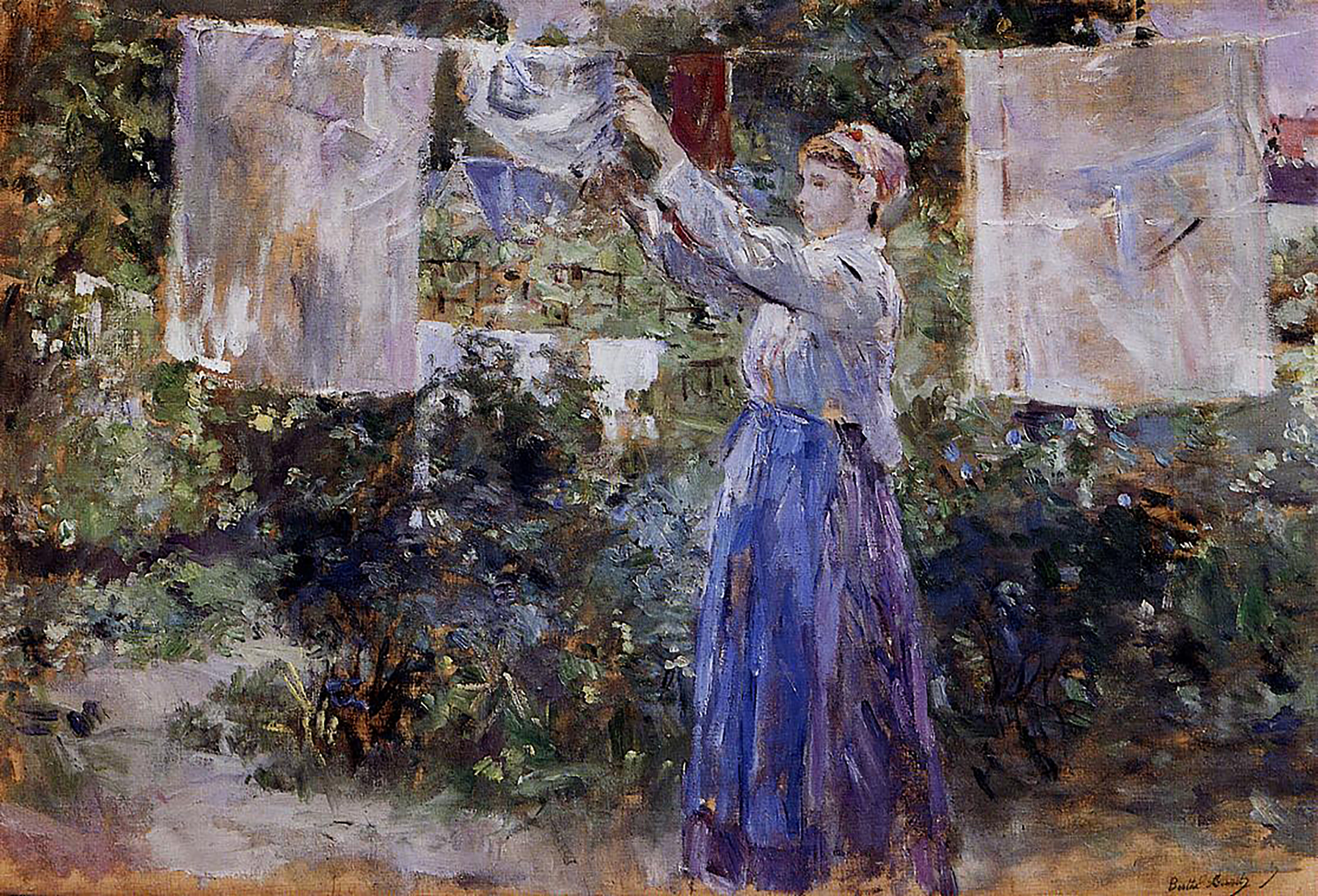
In the first instance, it is the use of color, that allows indoor scenes in Morisot’s painting to take on the feeling of the outdoors. In her journals, Morisot reflects frequently on color and the lightness of her palette was one of her distinguishing features for contemporary critics. In Carnet vert A (1885–86), for example, a page is dedicated to the use of color in a planned painting:
Maisons grises toit [grey houses roof]
Lilas [mots] Violet [word missing]
Persiennes vertes [Green shutters]
Clocher Lumière rose [Bell pink light]
Ombres lilas [violet shadows]
Deux toits rouges en dessous. [two red roofs below] (CVA, 261)
These comments follow those citing Manet cited earlier on the plein-air bedroom and also those citing Degas: “Degas says: Orange gives color, green neutralizes and violet gives shadow” (CVA, 261). The impact of Degas’s comment is seen directly in Morisot’s choice of shades of purple as shadows in many of her works, most notably in Peasant Woman Hanging Out the Laundry (1881) (fig. 4) or in Pasie Sewing (1881), On the Veranda, (1884), or Cottage Interior (1886). In the Carnet Beige (1885; 1887–88), we read again about her interest in the potential of color for shadow and how it is in her everyday interactions with Julie that she interrogates this:
Walking in Paris with Julie. … We sit down, and while looking at the play of shadows on the sand and the roofs of the Louvre, I think of my painting of the garden. I search with her to understand the relationship between light and shadow. She sees pink in the light and purple in the shadow.43
Morisot’s use of pinks for light and purples for shade will define both her outdoor and interior scenes. The use of green in interior scenes is also striking in her portraits, as we will see. Referring to her outdoor scene of Laundresses Hanging out the Wash (fig. 5), Arthur Baignières could see despite his reservations that Morisot “had rare talent as a colorist,”44 while Roger Ballu would write in 1877, “her initial studies miss, the drawing is off, but among these works, the tact and feeling for color cannot be denied.”45
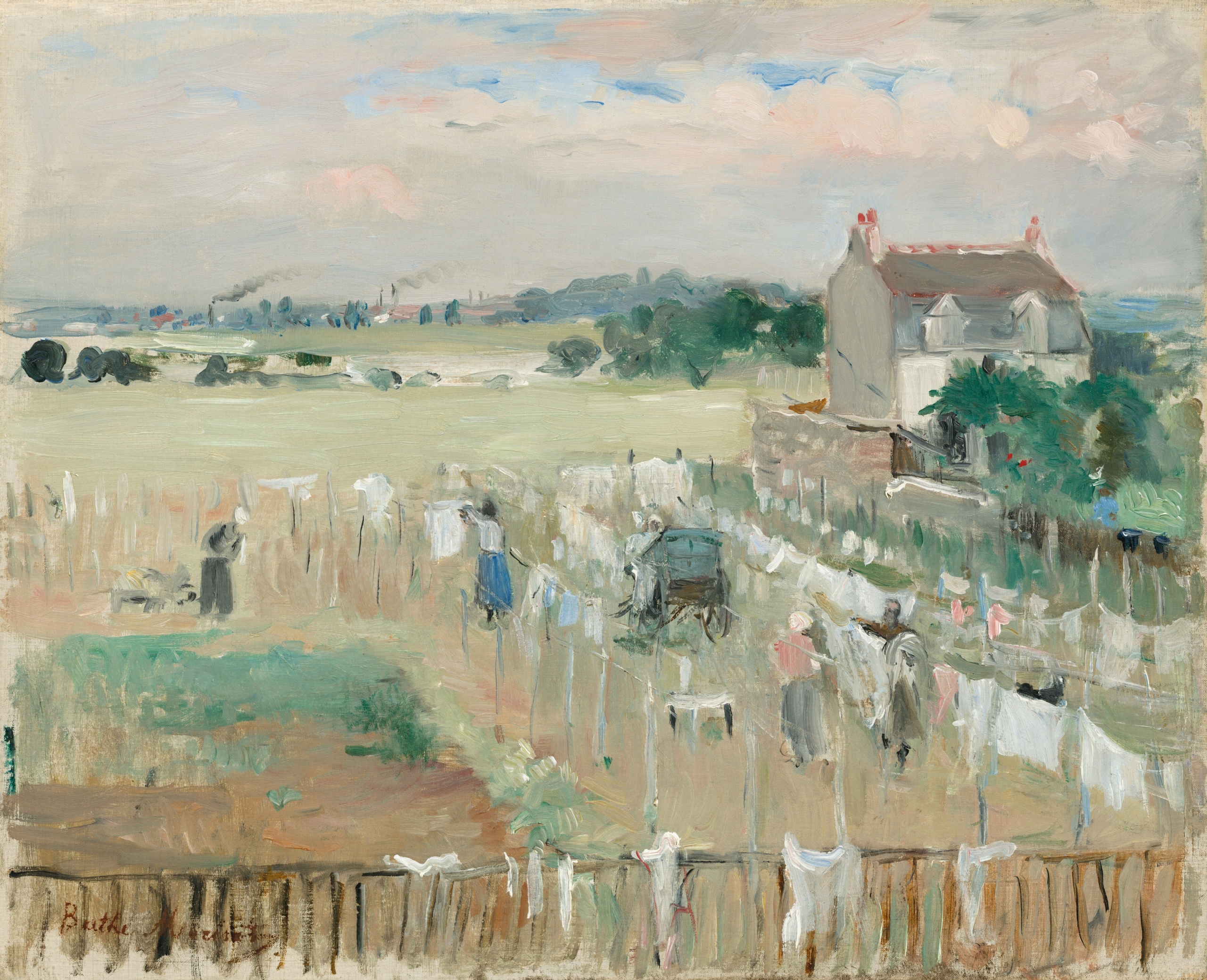
This emphasis on color was to continue in the positive criticism Morisot received towards the end of the decade.46 Key to her success was what was seen as the influence of the Rococo on her work. Critics noted that Morisot was “inspired by Boucher,”47 with others drawing formal links between the use of light tones in her work and the Rococo painters.48 As recent critics have observed, the “influence” of the Rococo painters was both genuine and strategic.49 Morisot’s failure to deny that she was the great-grand-niece of Fragonard allowed critics to perpetuate this myth, linking her to the Rococo and to a line of established artists.50 Her journals, however, also clearly show that she admired Rococo art: “Look at the graces in Boucher’s great paintings of Venus and Vulcan, the portraits of Madame de Pompadour by Boucher and La Tour, the admirable Perroneau …” (CVA, 258). Ephrussi’s comments on Morisot’s contribution to the 1880 exhibition can be ridiculed for their gendered links between painting and picking flowers, and Frenchness, elegance, and nonchalance, but his understanding of Morisot’s use of color and its effect on the viewer is important:
Berthe Morisot is French in her distinction, elegance, gaiety and nonchalance. She loves painting that is joyous and lively. She grinds flower petals onto her palette, in order to spread them later on her canvas with airy, witty touches, thrown a little haphazardly. These harmonize, blend, and finish by producing something vital, fine, and charming that you do not see, as much as intuit […] all [women] are seen through fine gray tones, matte white and light pink, with no shadows, set off with little multi-colored daubs, the whole giving the impression of vague opaline tints.51
The nature vocabulary is evident, but what is striking is how the experience of viewing the work is different from the other Impressionists. When Ephrussi writes on Degas’s Dance Exam in the same article, he is scathing of the “graceless poses and … intentional vulgarities,” mentioning “the astonishing strength of the drawing” but writing nothing on color.52 This is not surprising at a time when line was privileged over color. The distinction between line (seen as male) and color (as female) no doubt influenced the critics who praised Morisot’s use of color.53 But both Morisot and Renoir in particular used color to create form, with Renoir described by Morisot as “a great draftsman, as well as a colorist of the most exquisite feeling. Almost maladive in his sharpness” (CVA, 259).54 So, although critics may have favoured Morisot’s use of color because of its gendered associations at the time, Morisot herself was keenly experimenting with its potential, particularly in the use of light and shadow in interior settings.
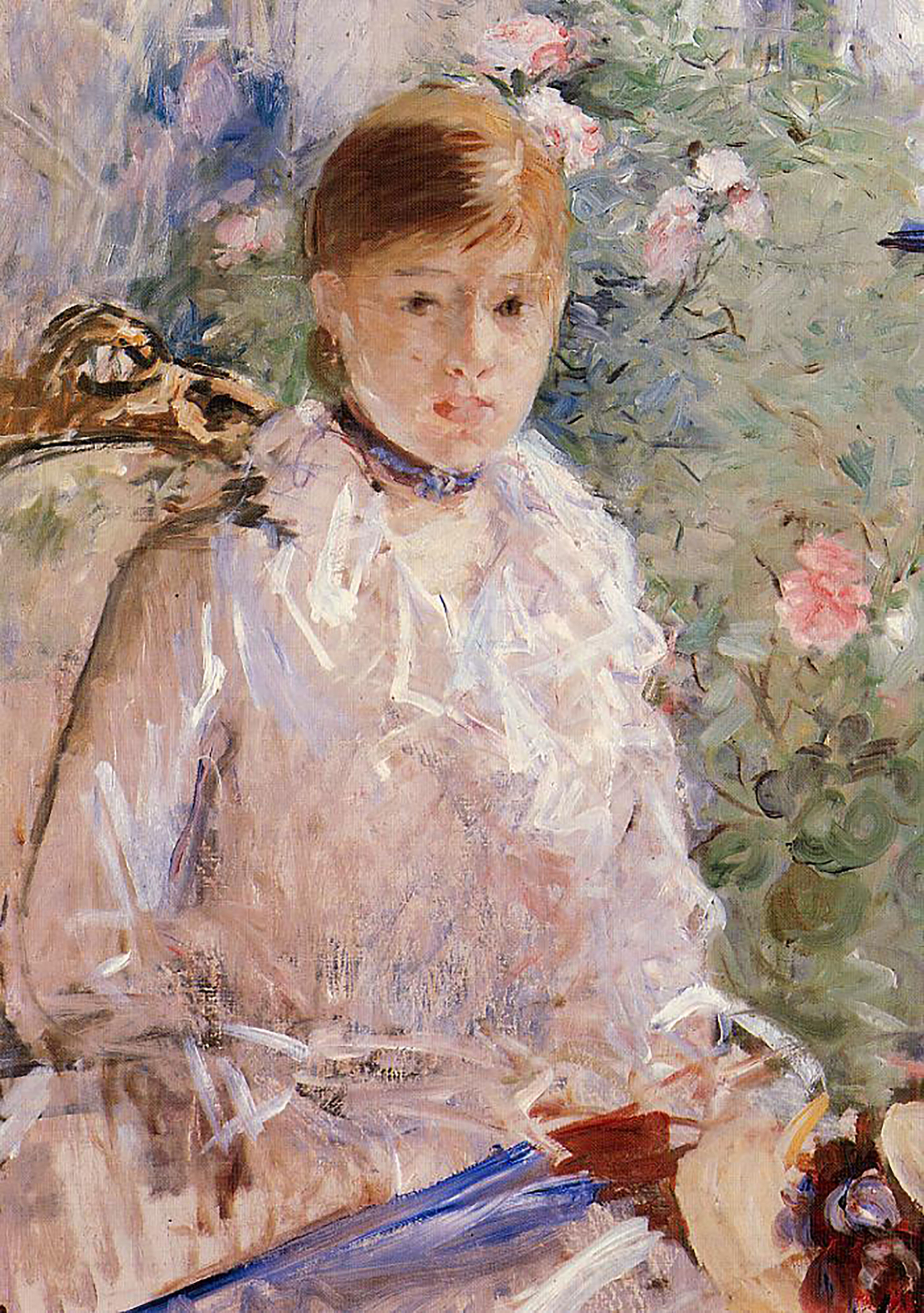
One of the best examples of a plein-air interior is Young Woman at a Window (Summer) (fig. 6), which was shown at the Fifth Impressionist Exhibition and where the model, dressed in white, is seated against a window through which we see large expanses of greenery and pink roses. That Morisot chose to give her portraits titles like Winter and Summer shows the ongoing concern with the predominance of landscape over figure in Impressionism.55 The idea of allegory is interesting here in that Morisot is using a trope to present figure paintings as a metaphor for landscapes. However, Morisot’s painting reveals a new type of portraiture: a candid, fresh, improvised-looking portrait of a young model that conveys immediacy and truth, an effect created through the close-up framing, light colors, and dynamic brushwork. It is worth requoting Mallarmé to understand the context: “This search after truth, peculiar to modern artists, which enables them to see nature and reproduce her, such as she appears to just and poor eyes, must lead them to adopt air almost exclusively as their medium, or at all events to habituate themselves to work in it freely and without restraint” (IEM, 30–31). Freedom is the key concept in Morisot’s aesthetic exploration, as hierarchies between outdoor/indoors, landscape/portrait are dismantled. Here, there is no clear distinction between the window frame and the shrubs, nor between the model’s dress and the chair. In later paintings, this exploration of greenery and background reveals a decorative turn in Morisot’s work.56 However, here we are really seeing an experimentation with the concept of plein-air painting in an interior. Arthur d’Echerac described Young Woman at a Window (Summer) as “a masterpiece of what can be understood as intuitive art,”57 again alluding to the affective aspects of Morisot’s work. Mallarmé convinced the director of the Musée des Beaux-Arts to acquire the painting in 1894, making it the first work of Morisot’s to enter a public collection, signaling its importance. But what is so radical about this modest-looking portrait? The use of light is of particular interest in the painting since for the light to fall in the way it does upon both the right and left sides of the ruffles of the dress and the face and hair, it would need to come from more than one source. It is likely that the painting was created close to or even on the balcony of Morisot’s home. Morisot’s painting is “fresh,” to use Mallarmé’s phrase, because it shows an interior scene in the style of plein-air.

When we look at Young woman Seated on a Sofa (1880) from the following year, we recognize the bar of the balcony and large rose bush (fig. 7). In this later painting, the artist has pulled the button-tufted sofa right up to the balcony so that the flowers on the sofa’s pattern, model’s hat, and planter fuse together. Clearly, Morisot is playing with the possibilities of balconies and windows to create outdoor effects indoors. Also, as Cindy Kang has argued, paintings such as these “stage or force the encounter between inside and outside. The relationship between indoors and outdoors becomes the point of artistic interrogation, leaving the viewer to question where one space becomes the other.”58 Contemporary critics were the first to note this fusion of indoor and outdoor space in Morisot’s works. While on the one hand, critics regularly referred to her indoor paintings using the vocabulary of the natural world outdoors, they also documented the destabilizing effect of her painting. For example, in 1880 Huysmans refers to her figures as “smelling of new mown hay and marzipan,”59 while Mirebeau in 1886 refers to her works as “disconcerting.”60 This point becomes clearest when we read Paul Manz comments on Young Girl in a Ball Gown (1879)61 (fig. 8), which clearly draws upon Stevens and Duran’s images of fashionable Parisiennes, as well as eighteenth-century art. The painting shows the close-up bust of a model, dressed in white, against a floral, leafy background:
Morizot (sic) excels in the mixture of subtly shaded pallid tones. For example, she paints the portrait of a woman in a low-necked dress sitting in a garden. The flesh is blond, vague flowers touch the grayed greenery with rosy lilac notes. Everything is floating: nothing is formulated. The tone itself hesitates, undecided, and there is in it a Fragonardian refinement, the feeling of a phantom world where colors do not yet have vitality, where the indistinct tones do not yet know that later they will acquire an individual character and a civil status.62
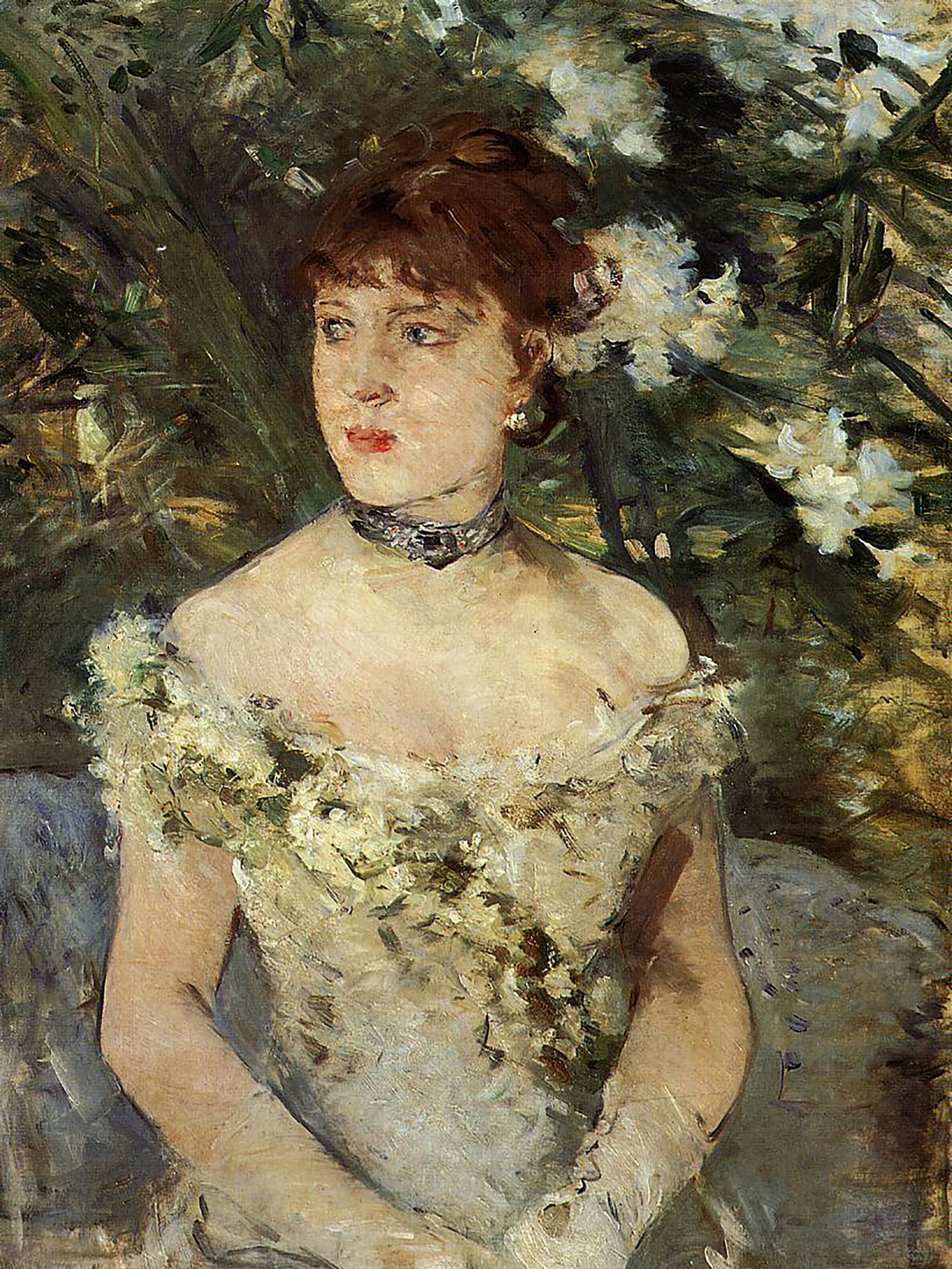
What Morisot does in Young Girl in a Ball Gown, as she does in so many of her female portraits, is to confuse interior and exterior. Again, the sofa has been pulled up against a window or balcony, and all blinds and shutters are thrown open, while real and fabricated foliage on fabrics mix in the viewer’s eye. The overall effect is a type of aesthetic confusion. As Roger Marx pointed out in an early critical text, this is also a work that challenges the understanding of portraiture: “[It shows] an energetic effort which leads her to no longer offer a reduced image [of the figure] but instead establish herself as a portraitist.”63
But this is a portrait that seems lacking in any psychological depth, that has a nameless sitter, and where figure and landscape/background are one. That Morisot labelled and exhibited this painting as Portrait is, I believe, very telling. As Michael Fried has recently argued, there was a noticeable transition from ambitious figure painting, in terms of the revolutionary type of works created by Manet, for example (Olympia, A Bar at the Folies Bergères, The Old Musician) to a focus on landscape in the late nineteenth century. For Fried, this “momentous shift” was seen in three distinct ways: the move to a modest picture size; an emphasis on unity and harmony; and thirdly, the issue of facture or brushwork (TMI). Fried acknowledged the role figure painting played in the Impressionist exhibitions and the favorable reviews by critics but goes on to say that by 1878:
It had become clear, or at least strongly arguable, that the heart of Impressionism as a school or movement was the landscape painters: Monet, Sisley, Pissarro, sometimes Cézanne, Renoir, Morisot, and Guillaumin. And of course that is how Impressionism has come popularly to be understood in our own time. (TMI)
This argument is compelling, and there is no doubt that landscape gradually superseded figure painting in terms of pursuing an advanced pictorial agenda. The critic’s point that “the large-scale abandonment of the ambitious figure painting tradition[] was barely noted” is, however, less valid when we take a close look at Morisot (TMI). She occupies, as always, a complicated position. On the one hand, together with Caillebotte, she offered twentieth- and twenty-first-century critics a clear contrast to the plein-air landscape paintings for which Impressionism became known. On the other hand, her figure paintings are far from monumental in size or striking in expression, but on the other, they are clearly ambitious in their formal concerns. Interestingly, Fried references the perspicacity of Rivière’s 1877 comment that “to treat a subject for the colors (tons) and not for the subject itself, that is what distinguishes the Impressionists from other painters” (TMI). This aspect of Impressionism is one that Morisot herself clearly engaged with both in her painting and her writings and which, as I argued earlier, contemporary critics first observed. Rivière’s comments on Morisot as “Mr Manet’s student” may easily be dismissed as sexist, but there may also be a truth in his comment that “her eye is sensitive, more sensitive than that of Manet’s” and that “some intelligent brushstrokes give a special charm to things.”64 If we return to Young Girl in a Ball Gown, it is clear that her labelling of the work as a portrait begs investigation. Unlike Mary Cassatt, with whom Morisot was often compared,65 Morisot does not identify or offer any personalities to these Parisiennes, but neither are they used to serve a narrative as in the work of Stevens or Duret. It is Mallarmé who points out the difference between Morisot and the genre portraitists: “The air of preoccupation, of mundane care or secret sorrows, so generally characteristic of the modern artist’s sketches from contemporary life, were never more notably absent than here …” (IEM, 33). The poet’s writings on skin in the same essay give more insight into what is novel in Morisot’s work:
Woman is by our civilisation consecrated to night, unless she escape from it sometimes to those open-air afternoons by the seaside … Yet I think the artist would be in the wrong to represent among the artificial glories of candle-light or gas, as at that time the only object of art would be the woman herself, set off by the immediate atmosphere, theatrical and active, even beautiful, but utterly inartistic. … The complexion, the special beauty which springs from the very source of life, changes with artificial lights, and it is probably from the desire to preserve this grace in all its integrity, that painting—which concerns itself more about this flesh-pollen than any other human attraction—insists on the mental operation to which I have lately alluded, and demands daylight—that is space with the transparence of air alone. … [I]n open air alone can the flesh tints of a model keep their true qualities, being nearly equally lighted on all sides. (IEM, 30–31)66
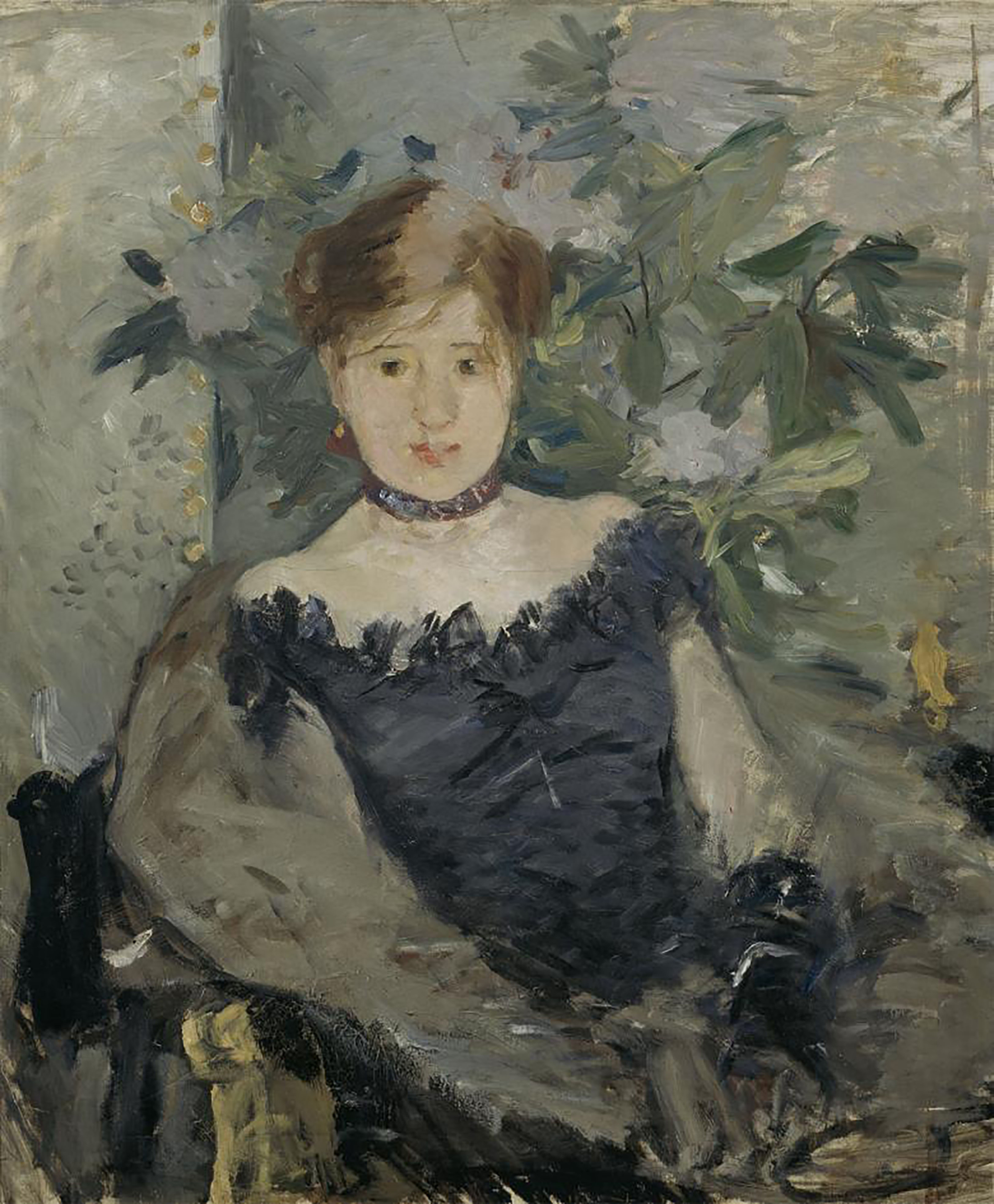
When we take another look at Morisot’s portraits, especially Young Woman in a Ball Gown, The Black Bodice (1879) (fig. 9),67 and Young Woman at a Window (Summer), it is the opacity of the skin, lit from all sides, that strikes the spectator. Mallarmé’s description of the complexion as a natural phenomenon is particularly relevant to Morisot. Her treatment of the model is no different from that of the natural environment, and what we see clearly in Young Woman in a Ball Gown is the “flesh-pollen” which allows the model’s skin to mimic the natural world. This is achieved through the interrelationship of the vigorous brushwork and the lightness of tones, which contemporary critics again were quick to note. At the Second Impressionist Exhibition, Alfred de Lostalot, though disdaining Morisot’s lack of finish, could see “her delicate color and the adroitly daring play of her brush.”68 Lightness or la peinture claire was at the heart of Impressionism, as Zola first observed in relation to Manet in 1867:
Edouard Manet works in a tonality brighter than the actual tonality of nature. His paintings are blonde and luminous, of a solid paleness. The light falls blonde and large, illuminating objects in a gentle fashion.69
The lightness of Morisot’s palette consistently struck contemporary critics. Burty writes of “the freshness of her palette,”70 Manz declared that “she was the only true Impressionist … no dark shadows dirty her work,”71 while Duret, despite his misgivings on her gender, writes:
Colors, on Mme Morisot’s canvases, are delicate, velvety and strangely languid. White is nuanced with reflections that make it tea-rose or ash-grey, carmine becomes peach, the green of the shrubbery takes on every effect and every color. The artist finishes her works by daubing here and there and on the background, light brush strokes, as though she were taking petals off flowers. For the ‘bourgeois,’ these paintings are only sketches; they are not finished. But if you fully embrace them and seize the unity, you will find them full of air, you will see the fore and backgrounds and the figures differentiate more clearly. The creatures that Mme Morisot places into her landscapes or her interiors are distinguished and pleasant, if sometimes a little weak as though they are tired from standing up.72
Duret’s choice of vocabulary is interesting—at once drawing upon nature and gender but also highlighting how Morisot’s use of brushwork and color make the unity or harmony of the painting. While critics writing on the 1877 exhibition were scathing of Monet and Renoir’s use of color,73 they were generally praising of Morisot’s colors, as discussed earlier. Ballu writes of Morisot’s “tact and feeling for color,”74 while de Lora states: “she can draw naturally when she wants to, and she uses color delicately.”75 From a formal perspective, it is color and light that defines Morisot’s plein-air interior aesthetic. The artist’s treatment of skin brings these two aspects together, most particularly though the use of white in what may be understood as Morisot’s most radical set of works: her Toilette paintings.
Whiteness and the Aesthetics of Skin in the Toilette paintings
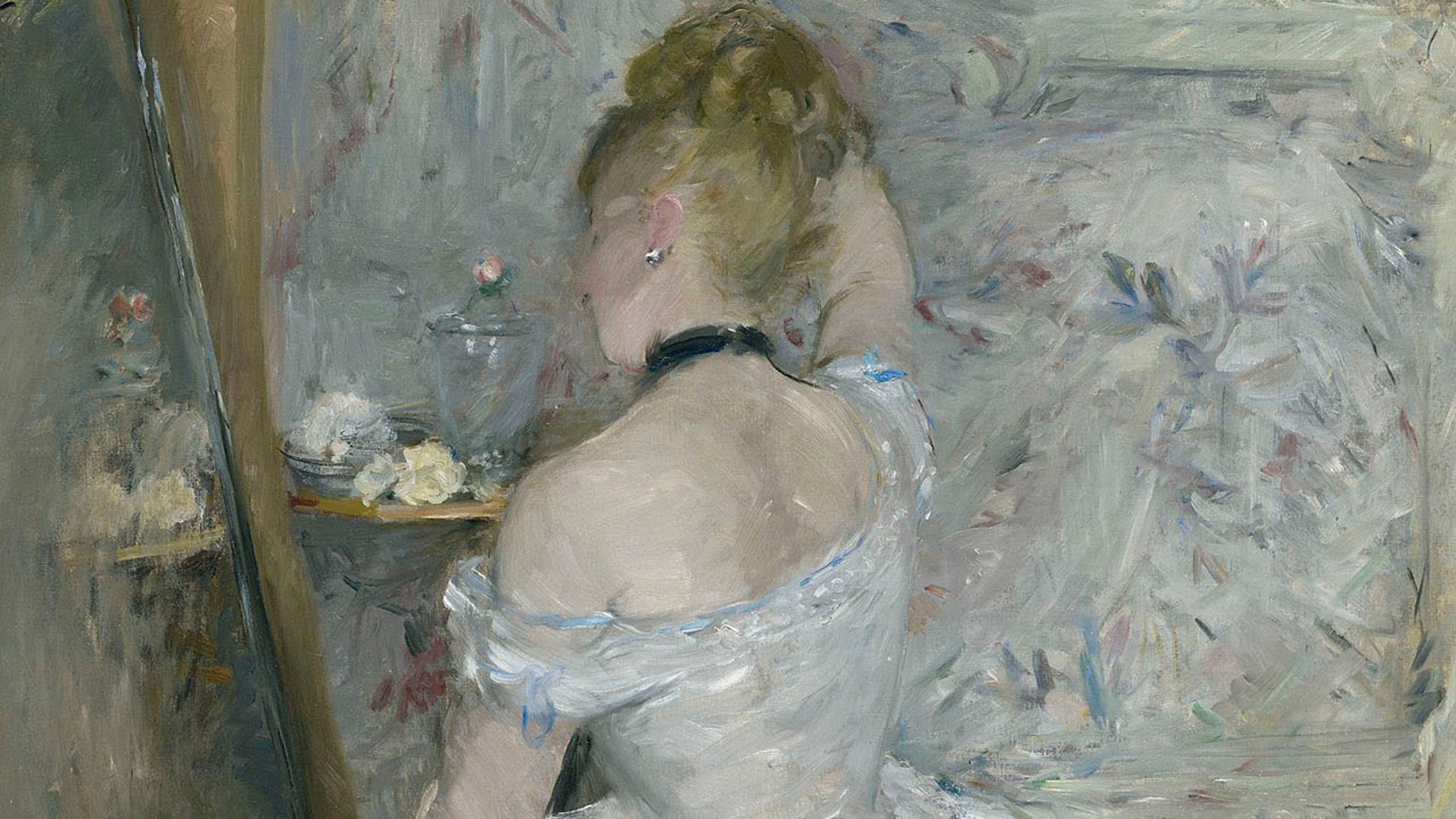
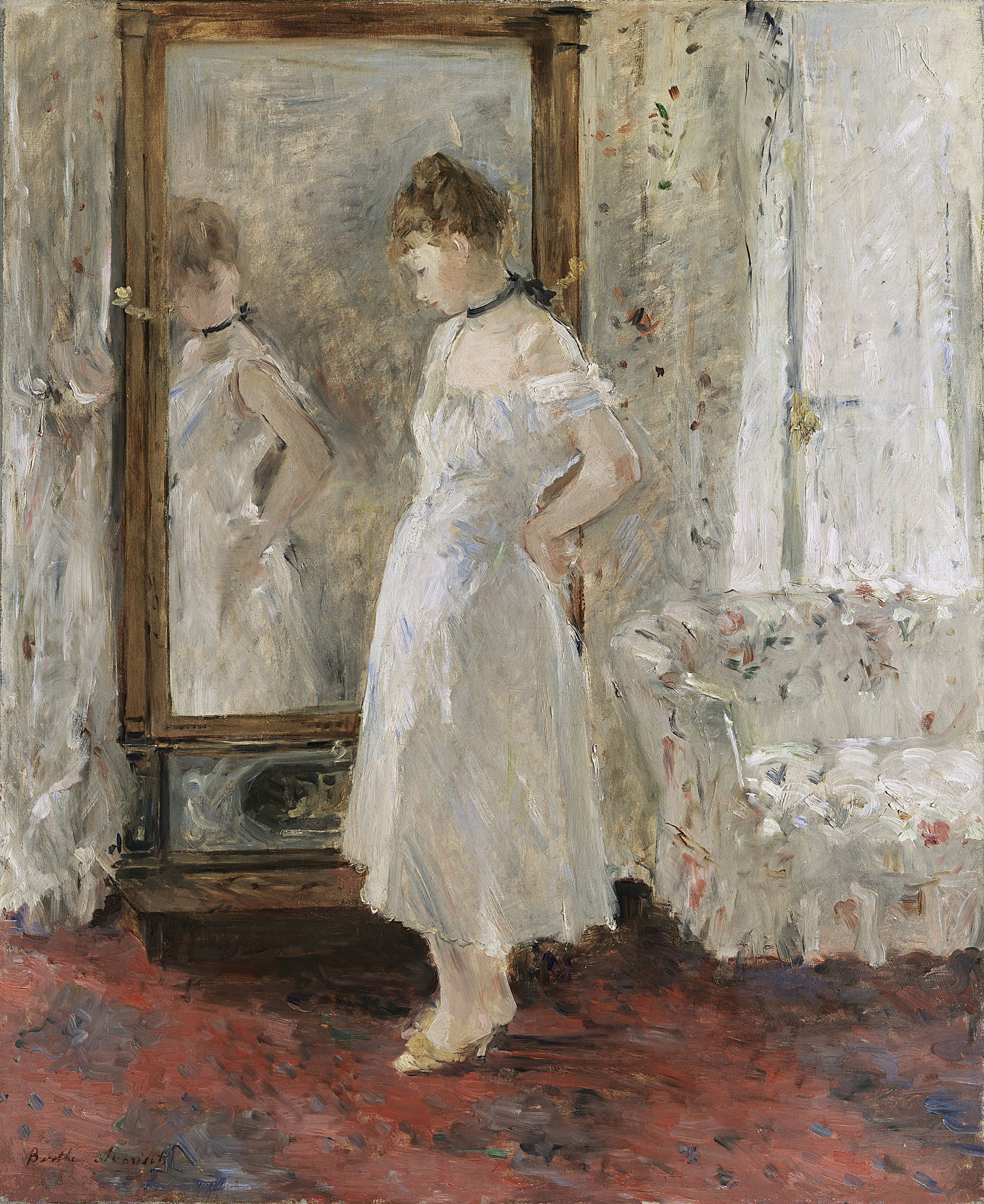
Toilette paintings such as Woman at her Toilette (fig. 10) and The Psyche Mirror (1876) (fig.11) gained much critical appreciation among Morisot’s contemporaries. On the one hand, these intimate scenes again could be linked in subject to the repertoire of the Rococo masters and also, in their bright pastel hues, find formal echoes with Fragonard, Boucher, and others. On the other, the always-strategic Morisot no doubt understood how the sensuality of the paintings, like those of the Rococo, could find popularity with a bourgeois audience. Via her feminine take on what could otherwise be perceived as salacious subjects, Morisot’s toilette scenes were socially acceptable scenes that could take pride of place in a bourgeois home.
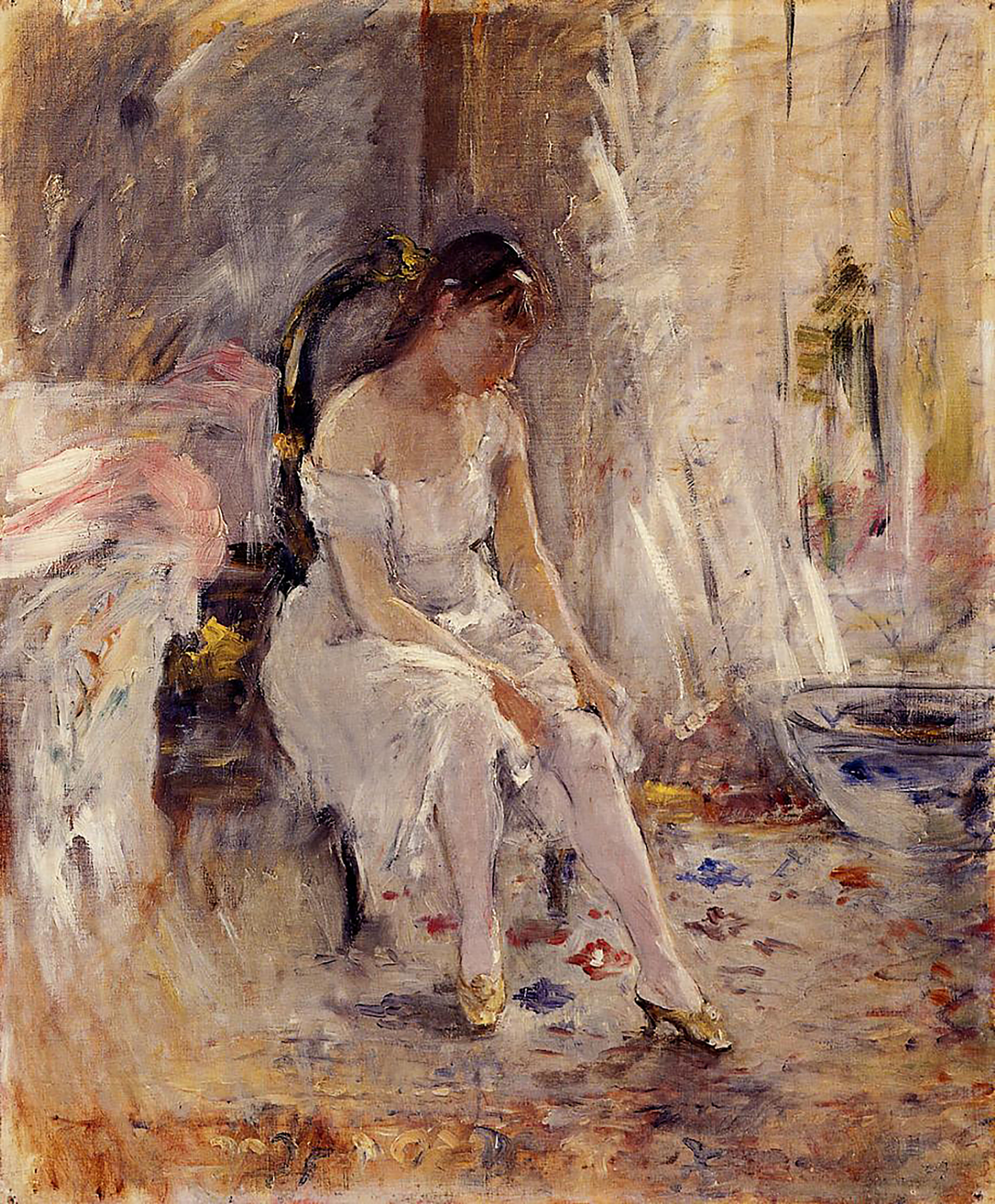
The sensual theme of a young woman putting on her stockings finds expression, for example, in Young Girl Fastening her Stockings from 1880 (fig. 12). Here, in a light-filled bedroom, a young model (also employed for the similar Young Girl Putting on her Skate, 1880) is seated on an empire-style chair with her negligee carelessly exposing her right shoulder, upon which the light delicately falls. The theme of bringing the outdoors in is felt through the presence of the balcony, visible through the muslin drapes and the floral motifs that are dappled across the rug and furniture. In the right-hand corner, cut-off, an empty blue planter with the barely visible stems of a plant, probably a rosebush, is seen, while the outline of a large mirror emerges to the left. It may be argued that this is a painting about the seen and unseen, veiling and unveiling with, at its core, the sensual motif of the young woman dressing. As in Manet’s Olympia (1863), it is the presence of the dainty yellow low-heeled slippers that emphasize the figure’s eroticism. The viewer is drawn to the shapely calf and ankle via the painter’s use of pure white color. For a critic who described the painting in 1896, the links with the Rococo were obvious: “This piece brings us right back to the 18th century. You would think we are at a feast of flowers, of pretty faces and of newly blossoming landscapes.”76 As Myers has pointed out, in this work, “nineteenth-century popular prints may have provided Morisot with a model for the modernization of gallant rococo subjects” (EN, 98). Fantin-Latour may also have been an influence, as well as Manet and Degas, who all produced erotic bathing and boudoir scenes. However, as the anonymous nineteenth-century critic suggests, Young Girl Fastening her Stockings has the feeling of a “newly blossoming landscape,” despite presenting as an eroticized interior scene.
From our perspective, the use of light and color, especially white, in these plein-air toilette works is particularly relevant. In The Psyche Mirror, we see a model standing in from of a cheval glass, most likely in Morisot’s bedroom, where we see the same floral button-tufted sofa and fashionable matching curtains that appear in many interior scenes from this time. Moreover, the large Empire-style mirror that dominates the scene reflects a similar pattern on the papered wall, and a rich red carpet decorates the floor, showing the wealth and taste of the Morisot-Manet home at rue Guichard. Of the paintings shown at the 1877 Impressionist exhibition, it received the most praise, a lot of it sexualized, with Rivière admiring “the ravishing thing that is the little woman in front of the mirror”77 and Arsène Houssaye commenting on the figure’s “exquisite curves that are almost chaste.”78 As usual, the lack of finish frustrated others such as Léon de Lora: “Have the courage to paint until you finish! A sketch will always be but a sketch.”79 However, more astute critics focused on Morisot’s mastery of light colors, especially the use of variations on white. Zola, for example, wrote that “the grey and white of the fabrics play a delicate symphony.”80
It is via white and her use of “white on white”81 that Morisot allows these indoor scenes to take on a different dimension. White personifies light and brings the outdoors in. Whiteness and lightness are also what attracted the praise of critics for Woman at her Toilette, and it is the work perhaps where we see the culmination of Morisot’s explorations of the plein-air interior. Silvestre, who championed Impressionism, declared, “I think one of the best works is the woman at her dressing table, seen from behind, whose ambered white skin is seen against a background almost as light.”82 Even more conservative critics like Manz praised its facture, calling it:
the dream of the unfinished. … The entirety is in gray tones spotted her and there with touches of pale pink. … nothing but a vague music, only hints, but so delicate! Watteau, Bonington and all the nymphs would understand this barely-there art.83
Manz’s references to Watteau and Bonington, like those of Ephrussi who sees it as having “a fugitive lightness, vivacity, sparkling and frivolous, reminiscent of Fragonard”84 give the painting a certain credence within the French art establishment. Others like Auguste Dalligny note the “irresistible attraction,” “finesse of tones,” and “the whiteness of the palette.”85 If we leave the sexual undertones aside in comments on the painting, we see quickly that the critics admire Morisot’s treatment of skin, and this is significant when we remember Duranty and Mallarmé’s key idea being that Impressionist painting is about painting skin out-of-doors. Yet Woman at her Toilette is clearly an intimate, interior scene, where the objets de toilette indicate a private space. Unlike the other Parisienne scenes, Morisot has not placed her subject on a balcony or near a window. The light here is imagined.
The painting was contemporaneous with Degas’s pastel, Toilette (1876–77), which shows a woman dressing with her back facing the viewer86 and also offers a réplique to Manet’s Before the Mirror (1876–77), revealing Morisot’s constant self-reflection on her art and modernist aesthetics and her ongoing dialogue with her colleagues. Yet when we compare Manet’s painting with Morisot’s the similarities and differences are clear: Manet’s subject is overtly sexual; the scene is clearly indoors, with bedroom/boudoir furnishing visible; his palette is light, but the facture is more finished with the drawing apparent. Morisot’s is more sensual than sexual, the facture is very loose, and the palette, although light, contains grey rather than warm tones. The main difference is that in Morisot subject and background merge so that the motifs of nature on the wallpaper seem to be one with the model’s skin, hair, and dress. In both works, it is the model’s white skin (warm in Manet and cooler in Morisot) that catches our eye and around which the meaning of the entire painting sees to hover. This whiteness is, as I will show, at the heart of Morisot’s radical aesthetics of the plein-air interior.
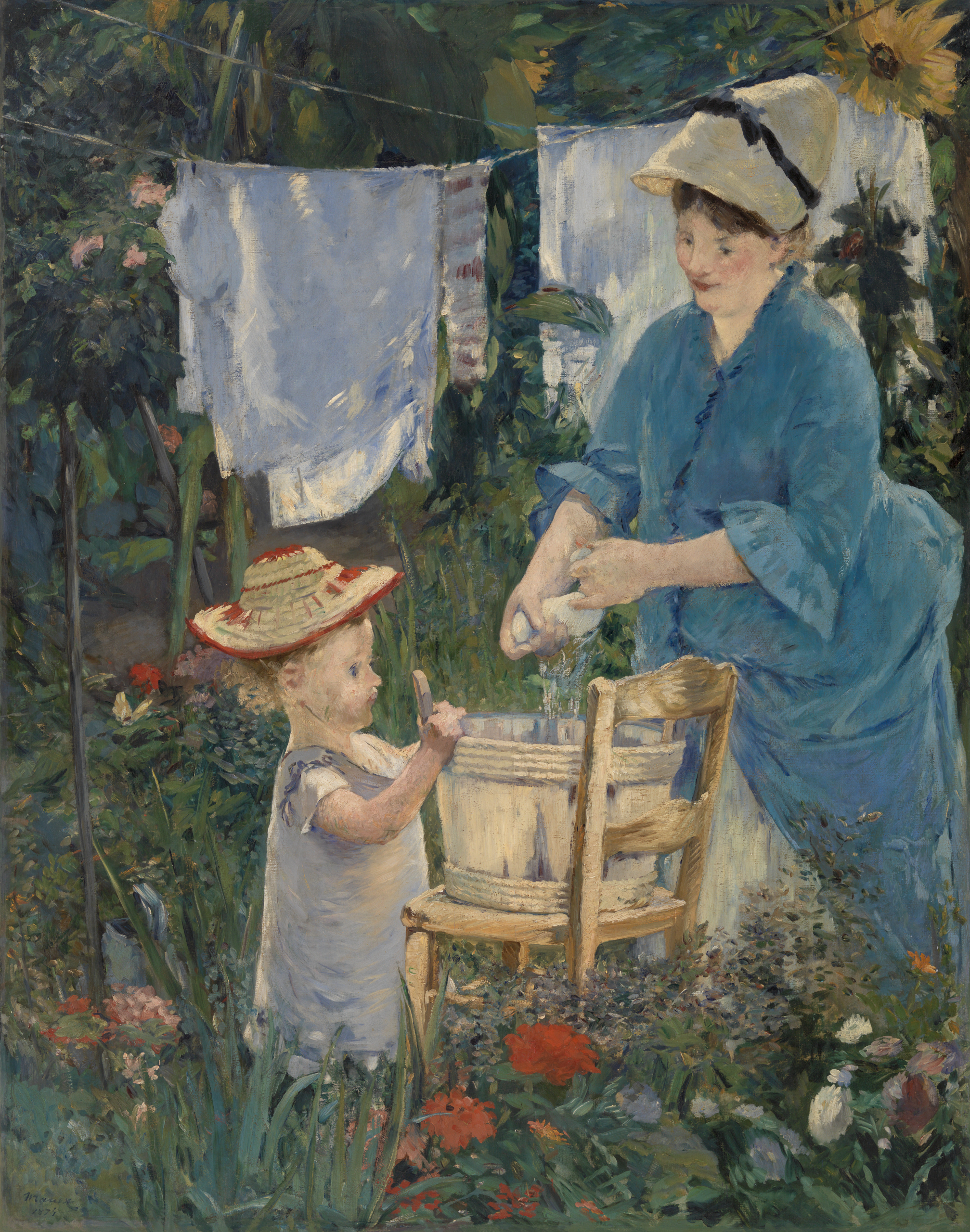
It is significant that Manet’s Laundry (1876) (fig. 13) is the work that Morisot writes about the most in her journals and that it was one of the works she chose to keep after the artist’s death. In the Carnet vert A (1885-86), Morisot describes the works of Manet that she owned.87 Of these Laundry is singled out: “Laundry, together with Argenteuil is his greatest expression of plein-air” (CVA, 258). The same painting is that which Mallarmé had identified as one where the “natural light of day penetrat[es] and influenc[es] all things” and which was “a complete and final repertory of all current ideas and the means of their execution” (IEM, 30). For the poet, this life-size painting of a washerwoman and her child is “deluged with air,” and this is its defining characteristic:
Air reigns supreme and real, as if it held an enchanted life conferred by the witchery of art; a life neither personal nor sentient, but itself subjected to the phenomena thus called up by science and shown to our astonished eyes, with its perpetual metamorphosis and its invisible action rendered visible. And how? By this fusion or by this struggle ever continued between surface and space, between color and air. (IEM, 31)88
This extract is interesting in that it mirrors thematically and linguistically the text where Mallarmé talks about Morisot’s art:
Creating poetry through art, a medium, whose power directly affects the spectator, without the artist’s intervention, and seems to awaken the luminous secret in surfaces, or in other words, chastely restores the rich analysis of life, through an alchemy of mobility and illusion. … Thus, let humanity rejoice in her preference for the soft flesh tints of the child, while yet prenubile, like a fruit, where this celebration of nudity tenderly ends. Our contemporary approaches her female model so as not to neglect her: the woman dressed for display, who is exoticized, transposed in curved lines or painstakingly labored over, as through created by a calligrapher, if not—to use literary terms—by a novelist. Miraculously, she reinstates this model, via a type of clairvoyance, with satin infused with life by contact with skin; the atmosphere of the pearly East revived. Or, forgetting the ideal, sets free the social grace imprisoned by style via a glimpse of nudity so that the meaning behind the dress bursts forth, expressing its relation to the garden and the seashore, a greenhouse, and the gallery.89
This celebrated extract from the preface to Morisot’s posthumous exhibition in 1896 became one of the defining pieces of writing on French modernity. Here, Mallarmé emphasized effect over subject and the power art to communicate the sense of other-worldliness using terms like “Féerie,” “rêve,” “alchimie,” “illusion,” “clairvoyance,” and “paradis” via an emphasis on the simple, ordinary things of life. It exemplified modernist suggestivity and abstraction, and the language Mallarmé uses is itself reflective of the effect he sees in Morisot’s art. The words the poet uses escape defined meanings, and the prose tantalizes the reader, all the while offering a glimpse into Morisot’s artistic world. The text is itself in keeping with the poet’s modernist aesthetics as famously outlined in 1864 to his friend Henri Cazalis: “I am creating a language which must necessarily spring from a quite new conception of poetry, and I define it in these words: paint not the thing, but the effect it produces.”90 It is how Morisot paints that brings out the hidden reality of things, “their luminous secret.” This “rich analysis of life” is, I argue, what is translated through Morisot’s vigorous brushstrokes and dazzling palette. From a linguistic perspective, the text employs similar strategies to the previous 1876 essay, linking the vocabulary of the divine and the magical (alchimie, clairvoyance, féerie) with nature (atmosphère, les jardins, la plage, enflant, plein-air). Thematically, both texts highlight the artistic vision that transforms the everyday and the ordinary (a metamorphosis). But this vision is enabled through a combination of “simple colour, fresh, or lightly laid on” and “an ever-present light [that] blends with and vivifies all things” (IEM, 30.) In Morisot, this “vivifying” happens with skin, satin, pearls, swans, powder. These signifiers, “signs; cygnes,” that allow the beauty of everyday life transport the viewer momentarily into a “spectacle of modern enchantment.”91 It is no accident that the objects Mallarmé chooses are white since it is via the color white that “the struggle between color and air, between surface and space” is most intensified. Susan Harrow has written eloquently about white and its importance in modernist art and literature. In her recent book Colourworks, where she focuses on Mallarmé’s monochromes of white, blue, and grey, Harrow offers a compelling argument for white as a “color of indeterminate identity, which makes it a privileged material for the modernist’s paradoxical sensibility”:
If white is generally accepted to be a colour, it is a colour of a quite different order: it is the alpha and omega of colours, and the sum of all the chromatic values in-between. Notwithstanding, white is often perceived as the space of colour’s absence or its evacuation: white may be the screen visualized before colour reaches it; white may be the ground that remains after colour has left. White is the inaugural space of colour, and it is, also, the afterlife of colour; it is thus the most resistant and the most intriguing of Mallarmé’s monochromes. White clings tenaciously to the materials of dispossession and dereliction, desire and distance, in his poetry: it is vividly present in the materiality of bone, lace, feather, foam, wing, onyx, star, fingernail, sail, canvas, or page, things that are so often evoked, and invoked. White is, also, the chromatic figuration of compelling emptiness.92
Harrow’s sensitive discussion of the color white strikes at the heart of what is radical about Morisot’s art. When Morisot paints the whites of skin, flowers, lace, muslin, porcelain, and powder puffs that we see in paintings such as Woman at her Toilette, she is engaging with the same ideas that fascinated Mallarmé: the effect, rather than the subject. The white light falling on white objects and the often-bare canvas that peeks through in these interiors is not really about revealing the subject, whether it is a woman reclining, dressing, or undressing, but it is more about the effect on the spectator in terms of both imagination and emotion. When Burty saw The Psyche Mirror and Woman at her Toilette in 1877, he wrote:
[Morisot] is a delicate colorist, who makes everything come together through a harmony of whites …. She paints young women in muslin robes, whose forms are blurred by the diffused light through the window’s muslin curtains. The faces and clothes are only hinted at but are strangely alive.93
Writing in an essay on Mallarmé and Impressionism for nonsite.org, Margaret Werth argued that the poet’s conception of air in his essay on Manet is intimately associated with the idea of meaning:
Both space and light are key to his conception of “air,” but this “space with the transparence of air alone” is unfilled not just by bodies or objects, but also by conventions and fixed meanings, and it resonates with the poetics of suggestion, silence, and invisibility so central to Mallarmé’s thought and work.94
This “transparency of air” is embodied in Morisot’s work through the color white, and no other Impressionist took it to such extremes. It may be argued that it is precisely because of her limitations and lack of access to the outdoors that Morisot was obliged to expand the aesthetics potentialities of white and the plein-air interior. As Werth explains in relation to Mallarmé’s “The Mystery in Letters,” it is the both the color and word “blanc” that signal its modernity in terms of the effect upon the reader:
The word blanc has an important role in Mallarmé’s writing and interpretations of it. This passage from “The Mystery in Letters” associates the blancs of writing and reading with ingenuousness, forgetfulness, chance, dissemination, nothingness, silence, virginity, transparency, air or song, and invisibility. Blanc refers to the white, unwritten page on which the black marks of a text might be inscribed and is associated with other blancs in Mallarmé’s writing (veil, sail, and cloud, for example, to mention three that appear in the Impressionist essay). But it also suggests, despite the difficulties Mallarmé’s text poses for the reader with its punctuation and syntactic confusions, the operation of blanks (blancs): the intervals, breaks (brisures), and spacings of writing and reading, which Mallarmé often associates with rhythm and music; and silence, nothingness (rien), and non-signification. “Air,” as Mallarmé uses it in “The Impressionists and Edouard Manet,” is akin to these notions of blanc.95
As Werth observes, the “blancs” are also those of spaces, silence, and suggestivity. It is the space of effect; le blanc is suggestive of les blancs, the unseen and unsaid that impacts the spectator. White, therefore, as in Mallarmé, represents the space of the imagination. So, on the one hand, Morisot’s use of hues of white, evokes outdoor light; on another level, it chimes with the blank canvas of the barely-there art of her early watercolors. The blankness of the canvas allows Morisot to privilege suggestivity over representation and appeals to the spectator’s memory, emotion, and imagination. Morisot’s use of white in the plein-air interiors is thus at once crude in its handling, yet subtle in its meanings, marking out her difference from the other Impressionists. But what is the importance of this in terms of modernism? If we return to Harrow, discussing Mallarmé, we read:
For the poet, it is not about asking what white might mean, but rather about speculating on what white might do in its own terms and in combination—and often in tension—with other chromatic values. Mallarmé’s writing invites us to shift our attention from identifying the signifying possibilities of white to tracking the agency of white.96
So, following this line of analysis, what does white do in Morisot’s plein-air interiors? In the first instance, Morisot’s white is the expression of light, reiterating Duranty’s idea that
strong light mitigates color, and that sunlight reflected by objects tends, by its very brightness, to restore that luminous unity that merges all seven prismatic rays into one single colorless beam—light itself.97
Using white in interiors maximizes the play of light upon objects and surfaces, creating that sense of a “luminous secret” hidden within ordinary things. But it also challenges and literally dazzles the viewer, ejecting them out of their comfortable place of passive spectatorship. This is particularly evident in the toilette scenes, which lure the (usually male) viewer in with a seemingly familiar lascivious subject only to usurp that gaze by reflecting the light back upon them. Works such as Woman at her Toilette are particularly effective in this respect. Here, the viewer is drawn in by the model’s naked shoulder and the peachy-white skin, but they are confused by the abstract background and the mirror whose angle should not reflect the flowers and bibelots in front of the model. The daring facture sees strokes of pure white, blue, and pink energetically burst through the canvas. There is a clear distinction between the dark space of the sturdy mirror frame on the left and the light-filled space to the right of the model, a contrast echoed in the black velvet choker and the loose white dress. It is impossible not to think of Manet and the evocative black chokers of Olympia, the barmaid in Le Bar aux folies-bergère, and, of course, those in his Portrait of Berthe Morisot (1874) and Berthe Morisot with a Fan (1874). The choker may be understood as a symbol of restraint and power. Morisot dressed her models in her own clothes and accessories and placed them in her own home.98 While this was no doubt a pragmatic decision to create a sense of realism, it also allowed Morisot to be present in her artworks in a way that was less available to her male counterparts, and the intimate effect of these private scenes is therefore enhanced. It may be argued that in works such as Woman at her Toilette, the male gaze is thwarted via the careful orchestration of the personal objects of the artist and the use of paint. Instead, Morisot’s very personal self-expression, in its restraint and power, translated through the effects of light, color and skin, comes to the fore.
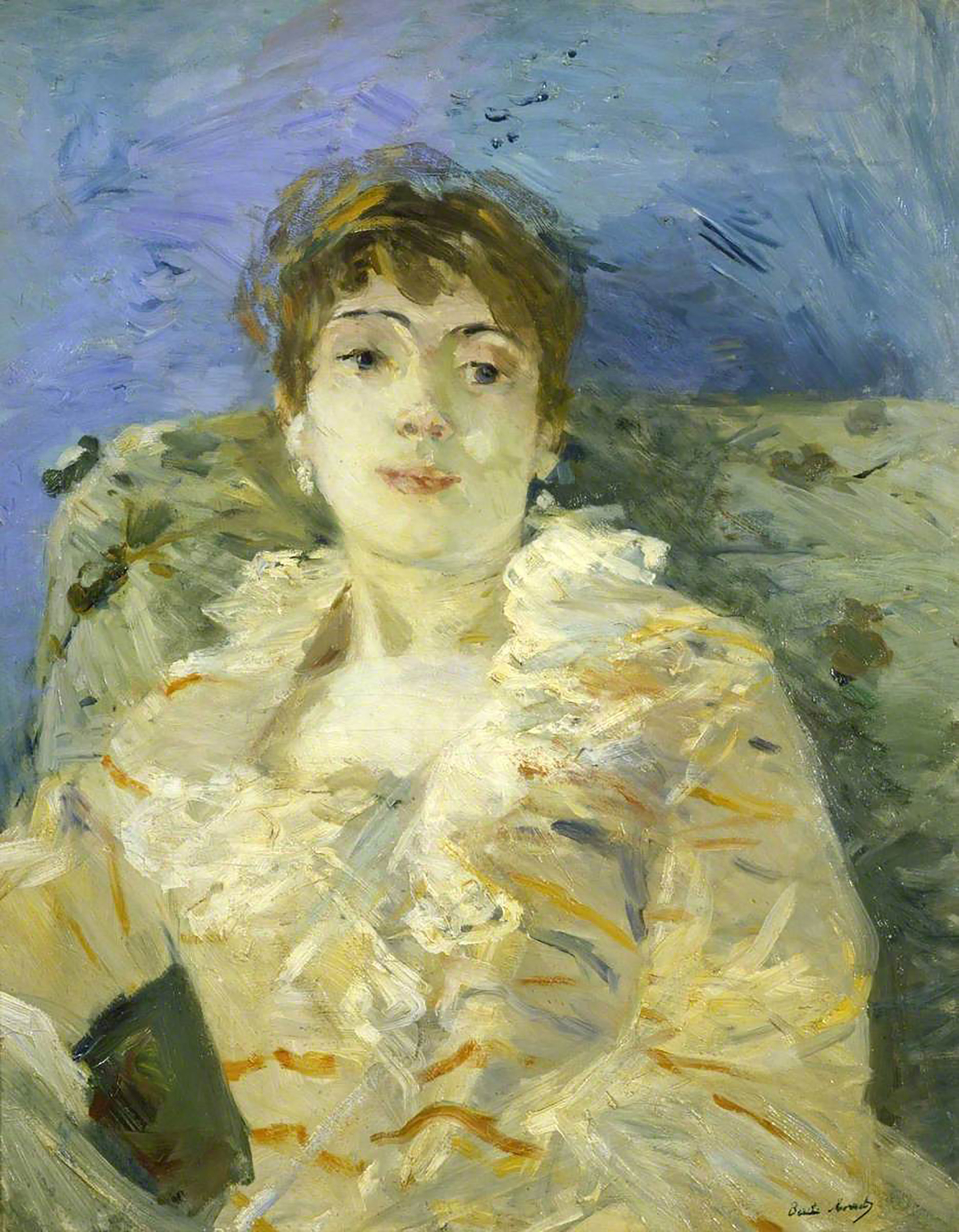
To conclude, it is important to reiterate that in the 1870s, in tandem with her explorations of the plein-air interior, Morisot wrote her most desolate letters to Edma. There is a fury to Morisot’s plein-air interiors that is translated through her use of color and brushwork. This is what disconcerts the viewer in works such as Woman at her Toilette since the purported voyeurism into a female dressing room is replaced with an artistic technique that vivifies the material and makes the act of painting palpable. The crude white strokes that characterize many of these works, from Woman at her Toilette to Young Woman at a Window (Summer) and Winter to the modernist vision of a “living woman with her turned-up nose” in Girl on a Divan (1885) (fig. 14), become Morisot’s signature and echo throughout her later work.99 It is in constraint that this aesthetic is conceived and developed, this whiteness a reminder of the physical limitations that forced Morisot to work indoors. Yet it is also emblematic of her meeting of minds with Mallarmé and the belief in the suggestivity and aesthetic potentiality of “blanc,” where it is never the thing itself but rather its effect that matters. Manz described Morisot’s work in 1881 as “increasingly metaphysical,”100 hinting at how observers understood that her goal was the expression of an idea, of a feeling. This is most evident in the plein-air interiors, where, to use Mallarmé words, “the meaning behind the dress bursts forth, expressing its relation to the garden and the seashore.”101
Morisot’s plein-air interiors are thus an essential part of the history of Impressionism. They are not separate from the outdoor experimentations of Manet, Pissarro, Monet, and others and instead, as a shrewd nineteenth-century observer pointed out, “provide a trait-d’union between the landscape and figure painters.”102 The neglect of these works in a historicizing approach that has privileged landscape over portrait and the urban over the domestic has resulted in the sidelining of the originality of Morisot’s aesthetics—an originality that was clearly visible to her Impressionist colleagues, its supporters, and its critics.
Notes